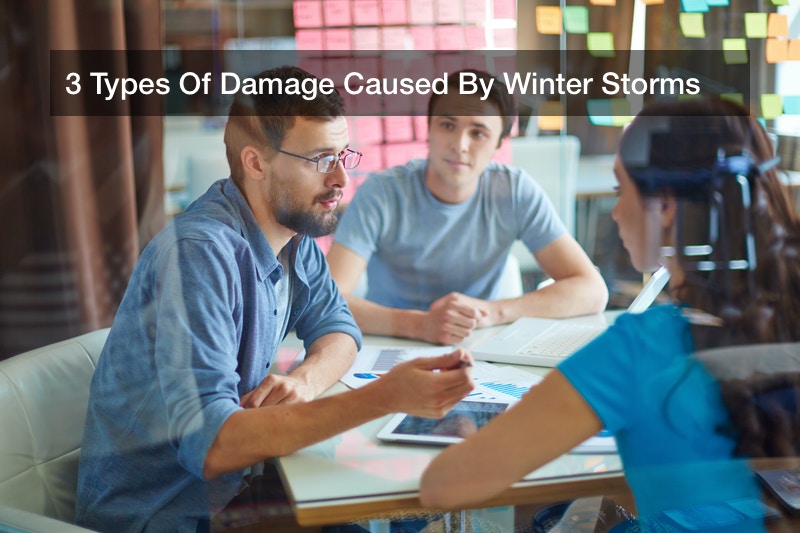3 Types Of Damage Caused By Winter Storms
4 min read
You never know when a winter storm is about to hit. While some types of storms can be predicted far ahead of time, winter storms often take us by surprise. When people do have time to prepare for winter storms, they often focus on getting the essentials from grocery stores. They stock up on water, milk, and eggs, as well as non-perishables that they can survive on until power is restored to their homes. We’ll all get ready to use our fireplaces, and stay warm and dry. The fact is that many of us don’t focus on — understandably — what will happen to our homes during the winter storms, and what we’ll do to repair the damage done during the storms. Lots of people don’t realize that there are plenty of ways for a home to be damaged during a winter storm, just as it would be during a hurricane or tornado. The winter presents not only potentially devastating cold, but an onslaught of snow and ice that is ultimately water, and can damage structure just as water would in its primary form. For that matter, the freezing effects that a home can experience, as well as the harsh winds often experienced during a winter storm, can cause uniquely devastating forms of damage.
It’s important to remember that there are some forms of damage that are impossible to prevent ahead of a winter storm. However, with enough work — and yes, enough money spent — most of that damage can be repaired. With that being said, let’s look into the most common types of home repairs required after a winter storm.
1. Water Damage And Mold Remediation
While all homes can experience water damage during a winter storm, some homes are certainly more vulnerable than others. In particular, homes with basements can be damaged by winter storms. It’s estimated that about 98% of all homes with basements will experience some kind of water damage over time. The issues that can occur during winter storms are manifold. For one thing, a typical winter storm will create a buildup of snow and ice on the ground. It could be some time before that snow and ice begin to thaw, depending on the temperatures in the area. However, when it does begin to thaw this essentially creates a flooding effect, with the snow and ice mixing with dirt. This muddy slush can seep into a home’s basement, causing not only water damage but mold. The mold is particularly harmful in theory, as it could cause a number of health problems for those within the home as well. Many people don’t even realize that winter storms cause water damage to basements, which means that they aren’t as vigilant about checking for deep damage as they would be with a typical storm. In fact, the way that a home is heating during the winter could, in fact, encourage the growth of mold, and therefore even more damage. This means that people should take the issue much more seriously than do right now.
2. Frozen Pipe Repairs
You may expect there to be some degree of freezing after a winter storm. Many people do go without not only power but running water following a winter storm, precisely because of this freezing. However, the issue can be much more prolonged if your pipes freeze so badly that they’re seriously damaged. Essentially, any type of pipe or tube that carries water to consumers is a water pipe. As water freezes in these pipes, it expands. This can cause frozen pipes to burst, which in turn could render a house’s entire plumbing system useless. This kind of fix cannot be made without the help of professionals. It’s important to act quickly and to get in touch with plumbing repair companies if your water isn’t running following a winter storm. Chances are that you won’t be the only person with burst pipes in the area following the storm; acting quickly will mean that the issue will be remedied faster. In some cases, these pipes can be repaired without a total replacement. However, at times this type of damage requires the replacement of certain pipes. Although some people leave their faucets dripping throughout a winter storm to keep their pipes from freezing, it’s virtually impossible to keep your pipes from freezing or bursting during a storm. Therefore, you should keep your home as warm as possible, and stock up on water ahead of time.
3. Roof Repair
Winter storms can present some of the strongest winds that you can experience — which is why most people are advised to hunker down and wait out the storm, rather than attempting to brave it. Furthermore, homes are not only being battered by the wind itself but often snow and ice as well. Therefore, it’s really no wonder that these types of storms often cause roof damage. If your roof has been damaged following a winter storm, any repairs or replacements should be made with longevity in mind. If you must replace your roof and it doesn’t already have asphalt shingles, you may want to choose them for the next go around — asphalt shingles are not only relatively inexpensive but also long-lasting. They provide protection for about 12 to 15 years, which will ideally leave them in place for the next winter storm.
Even if you can’t prevent storm damage entirely, you can prepare for the repairs you may have to undergo. Keep a cool head, tend to the repairs quickly, and strengthen your home in whatever way you can with the next winter in mind.





